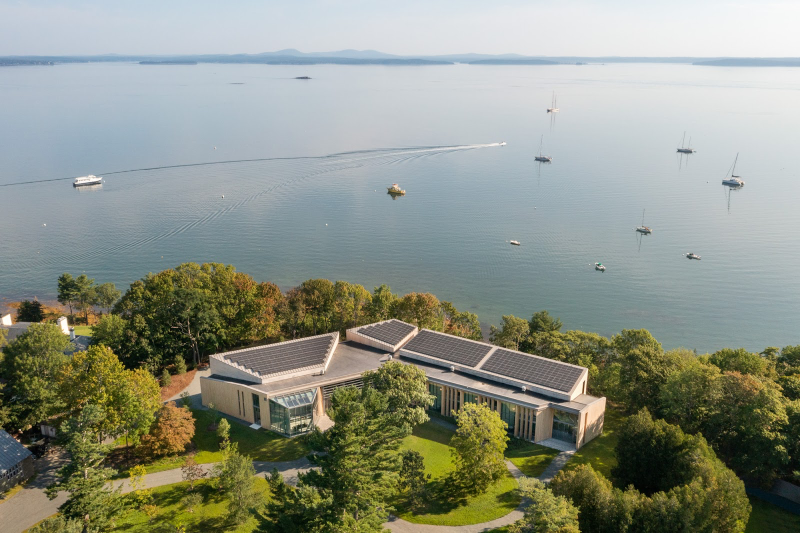OPAL, a local Belfast architectural firm and leader in sustainable design and environmental stewardship, said June 10 that it has earned national recognition for the design of Bar Harbor academic building. The Davis Center for Human Ecology at College of the Atlantic in Bar Harbor has received the AIA National Architecture Award — the highest level of recognition possible for a specific project from the American Institute of Architects.
The Davis Center for Human Ecology
The design for the Davis Center is a collaboration with New York based Susan T. Rodriguez Architecture • Design and OPAL. The design draws inspiration from COA’s environmentally focused, interdisciplinary curriculum and from the history and ecology of its oceanfront campus, on Maine’s Mt. Desert Island, according to a news release.
Sited on a bluff overlooking Frenchman Bay, the building extends an existing campus-wide spine of circulation and gathering spaces northward, toward the shoreline. Powered by COA’s dedication to sustainability and building performance, the Davis Center sets a new benchmark for future-oriented academic buildings in far northern climates.
- The building meets the newly released national definition for Zero Emissions Buildings, or ZEB, a Biden-Harris Administration initiative which OPAL Management Partner, Timothy Lock, collaborated on and helped facilitate.
- Designed to the stringent German Passive House standard of energy efficiency and indoor air quality, it consumes 90 percent less energy than a comparable code-compliant building.
- Passive solar gain from south-facing glass mitigates heating demand during Maine’s long, cold winters. A high-capacity energy recovery ventilation system provides a constant flow of tempered fresh air.
- The design extensively uses low-embodied-carbon and locally sourced materials—including a nearly all-wood structure and wood fiber insulation—which radically reduce its lifecycle carbon footprint, effectively neutralizing the environmental impact of its construction.
- The building accommodates art studios, offices, teaching and collaboration spaces, science labs, and a greenhouse for programming in zoology, botany, chemistry, geology, general science, fine art and media.
- The building design maximizes views of the ocean and frames an open green used year-round for ceremonies and outdoor activities.
Statement from OPAL Partner Timothy Lock
Timothy Lock, OPAL Management Partner, emphasized the significance of this National Award in a statement: “We are thrilled to be acknowledged for a project so dear to our heart and for a client so uniquely identified with Maine. The building represents a new milestone for what is possible within the context of ecological building design, and will set a new benchmark both within our practice, and now with this acknowledgement, across the country. Academic buildings, particularly those with labs, tend to be thought of as energy hogs that cannot be avoided, and this is anything but. Additionally, this is a huge moment for Maine architecture and design, for this project to be recognized at this level. Moreover, I am so grateful for our collaborative partnership with Susan Rodrgiuez; Susie and I have a very special working relationship that is evident in the seamless weaving of the cutting-edge design and sustainability seen in this project, and I am happy others have seen it too.”
OPAL Designs Second Sustainable Building for COA
A second building designed by OPAL for College of the Atlantic, a new student housing building, has just been completed this spring on campus. The new Collins House dormitory includes 46 beds for students, and continues the legacy of the highest standards of efficiency and ecological design on the COA campus. The new dormitory is built from a biogenic mass timber structure, paired with wood infill walls, and wood fiber insulation; the all-wood assembly sequesters biogenic carbon while performing at Passive House level energy, upholding the highest standards of sustainability.

































